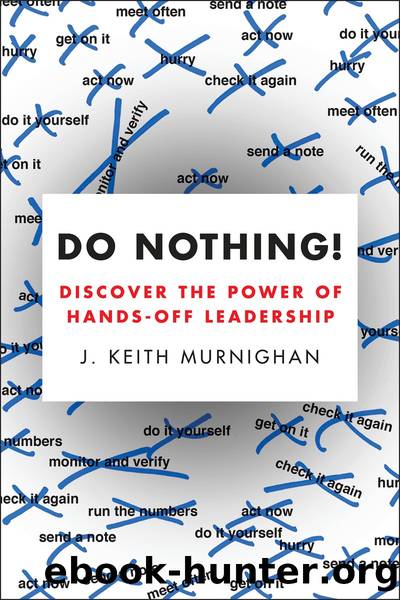Do Nothing! by J. Keith Murnighan

Author:J. Keith Murnighan
Language: eng
Format: epub
Publisher: Penguin Publishing Group
Published: 2016-03-30T09:44:53+00:00
* I donât want them to read chapter 5 because it reveals too much about an exercise that we do in our last class session. If too many people know too much about the exercise, it loses its impact. If only a few people know about it, it still works.
6
Bear Down Warmly
NICE GUYS FINISH last. Although this old saying is often repeated, is it true? We can all think of anecdotes about people who are nasty but successfulâfor example, executives who have gotten nicknames like âChainsaw Alâ and who have moved from one executive position to another. But what about general trends? Should leaders be kind to their team members most of the time, or should they be tough? Should they be open to ideas or be directive? Should they delegate extensively or be sure they are always in control?
The answer to all of these questions is âYes.â Leaders must do all these things. In fact, leaders must be wire walkers: they must be able to walk a fine line between control and democracy, between delegation and taking responsibility, and between kindness and direction. Striking this balance is one of the biggest challenges that effective leaders face. Fortunately, there are solutions to this challenge, and research on effective leadership strategies gives us a host of hints about the nature of these solutions.
Researchers have been studying leadership for decades, and the findings of each research study, in its own area, have been tremendously consistent. Over and over again, data indicates that leaders need to think carefully about two major issues, the task and the people. At the same time, however, a challenge comes from the fact that the findings on tasks and the findings on people are somewhat contradictory: effective leaders must push people to do more on their tasks and they must sincerely care about them at the same time. Neither requires that leaders do any work themselves, but determining how to combine the implications from the research on tasks and the implications from the research on people is not immediately obvious. Before we jump to conclusions, letâs consider what each separate area of research tells us.
The Task
In terms of the task, the lessons are clear: to be effective, leaders must push people to do more than they otherwise would. Encouragement, high expectations, and a figurative but almost physical push can all help people achieve more than they would naturally expect or choose to do. People tend to be conscientious: they want to appear responsible and trustworthy, so when you give them a job, nearly all the time, they do it.
But then they stop. Only rarely do people do more than they are asked to do.
How can I make such a strong claim? Think of your own career. Think of the work that accumulates whenever youâve been out of town and how you have called a meeting of your team members after your return so you could assign each of them a job to help you get caught up. When
Download
This site does not store any files on its server. We only index and link to content provided by other sites. Please contact the content providers to delete copyright contents if any and email us, we'll remove relevant links or contents immediately.
| Bookkeeping | Business Mathematics |
| Business Writing | Communications |
| Decision Making | Negotiating |
| Project Management | Running Meetings & Presentations |
| Secretarial Aids & Training | Time Management |
| Training |
Nudge - Improving Decisions about Health, Wealth, and Happiness by Thaler Sunstein(7656)
Deep Work by Cal Newport(6966)
Principles: Life and Work by Ray Dalio(6296)
The Doodle Revolution by Sunni Brown(4713)
Factfulness: Ten Reasons We're Wrong About the World – and Why Things Are Better Than You Think by Hans Rosling(4713)
Eat That Frog! by Brian Tracy(4483)
Thinking in Bets by Annie Duke(4184)
Hyperfocus by Chris Bailey(4086)
Visual Intelligence by Amy E. Herman(3752)
Writing Your Dissertation in Fifteen Minutes a Day by Joan Bolker(3696)
Ogilvy on Advertising by David Ogilvy(3552)
How to Win Friends and Influence People in the Digital Age by Dale Carnegie & Associates(3518)
Hidden Persuasion: 33 psychological influence techniques in advertising by Marc Andrews & Matthijs van Leeuwen & Rick van Baaren(3517)
How to win friends and influence people by Dale Carnegie(3437)
The Pixar Touch by David A. Price(3389)
Schaum's Quick Guide to Writing Great Short Stories by Margaret Lucke(3343)
Deep Work: Rules for Focused Success in a Distracted World by Cal Newport(3182)
Work Clean by Dan Charnas(3080)
The Slow Fix: Solve Problems, Work Smarter, and Live Better In a World Addicted to Speed by Carl Honore(2975)
